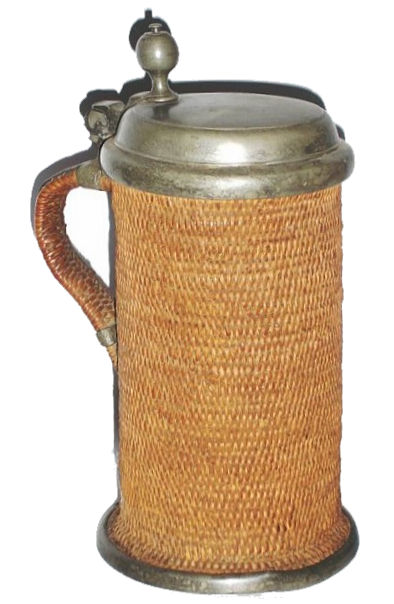A Basketry Stein
By Judy Stuart This
is a one liter beer stein made of woven fibers often called cane.
The tall cylindrical body is triple ‘woven’ (that is three layers of
thickness to prevent leaking) with a flat strap handle made of basket
material of the same type of weave. The base rim, lip rim and
handle strap as well as the lid are made of pewter which is well fitted
to the proportions of the basket material which changes size slightly
as the external humidity affects the woven materials.
This
is a one liter beer stein made of woven fibers often called cane.
The tall cylindrical body is triple ‘woven’ (that is three layers of
thickness to prevent leaking) with a flat strap handle made of basket
material of the same type of weave. The base rim, lip rim and
handle strap as well as the lid are made of pewter which is well fitted
to the proportions of the basket material which changes size slightly
as the external humidity affects the woven materials.Basketry is the weaving of unspun vegetable fibers, usually to form a container. Baskets have been made from any wood, vine, leaf, or fiber that could be formed into a desirable shape. In every civilization and every part of the world, basket making has been practiced. Baskets were the paper/plastic bags of their day; needed as carrying vessels, baskets were probably eventually replaced by clay pots, which were often more durable.
There are generally five types of basketry. “Coiled” basketry tends to use grasses and rushes. “Plaiting” uses materials that are wide and ribbon-like, such as palms or yucca. “Twining” uses materials from roots and tree bark. “Wicker” and “Splint” baskets use reed, cane, willow, oak and ash.
Basket steins were made in north-central Germany, up until about the first quarter of the 18th century. If the baskets (whether steins or carrying vessels) were well used, the material would tend to abrade and eventually break causing the baskets to unravel, rendering them useless. That is why really old baskets or basket steins are so rare today. Baskets continue to be handmade as no one has ever improved upon the earliest and most basic techniques of basket making.
Coiling style, which this basket is, is a technique of winding up the vegetable fiber like a snake while stitching it every inch or oftener to the row before it. The inner core of the coil is usually bundles of grasses or a fairly pliable vegetable fibers. The wrapping and sewing material (which covers the core material, holds the basket together and helps to shape it) is a stronger fiber from trees and larger vines. This basket is made from European willow, which is a woody plant that can be harvested and re-grown the next season.
The exterior of the stein is likely the ‘bark’ or outer covering of the willow stem that has been stripped from the stem after the boiling and cut into fairly even strips that are used to wrap and then ‘sew’ the cores one on top of the other, thus building the columnar shape of the stein.
This basket was made in the early 1700s and when held up to the light today and looked through the inside of it, there are only two pinholes of light that can be seen. So after 300 years, this natural material is still virtually water-tight.
